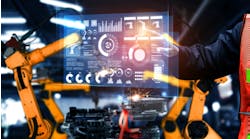Humans and machines learning new approaches to supply-chain resiliency
Amazon Web Services recently launched AWS Supply Chain, a new cloud application that promises to improve supply chain visibility and deliver actionable insights to mitigate supply chain risks, lower costs, and improve customer experiences.
Bold claims.
We wanted to learn more, so we connected with Diego Pantoja-Navajas, vice president, AWS Supply Chain with Amazon Web Services. Take a look…
Smart Industry: What role does machine learning play in developing supply chain resiliency?
Diego: Machine learning is a broadly transformative technology that is being used to improve the resilience of supply chains. We see this coming into practice at several different layers.
We’ve heard from our customers that they needed ways to aggregate data across a myriad of disparate ERP and supply chain systems into a single canonical-data model, in order to have all of their supply chain data in one place in the same form. Machine learning and natural-language processing have been instrumental in enabling customers to aggregate this data more quickly and easily, without needing to re-platforming onto a new system, by automating much of the heavy lifting involved in associating data from one system into another.
That’s the first challenge that machine learning helps customers address—getting all of the data needed from across the supply chain together so it can be used to generate useful information, insights and actions. However, once you have all of the data you need in one place, you still have to make sense of it. Our supply chain customers are often dealing with data from millions or even billions of transactions—far too much for unassisted human brains process.
Fortunately, one of the hallmarks of machine learning is its ability to extract meaning from very large data sets. So with an assist from machine-learning technology, once you have all your data in one place, you can use that technology to extract meaning from it to perform business tasks such as predicting supplier lead times based on real-time conditions, identifying potential demand spikes, or having machine-learning models propose recommended actions to address supply-chain risks.
And it’s still early days. We expect that machine learning will be used for a growing number of supply-chain applications as more customers move to the cloud.
Smart Industry: How is supply-chain resiliency changing as we emerge from this period of supply-chain crisis? Are we more resilient with hard lessons learned?
Diego: Supply-chain strains experienced over the last couple years are a symptom of an underlying shift from a supply-based model to a new demand-based model, exacerbated by some pretty big exogenous shocks. Supply chains that have been built to reactively respond to supply shocks and increasing customer demands (rather than anticipating them) has meant that when disruptions occur, companies are less able to mitigate those disruptions.
A lesson learned is that we need better modernized infrastructure, and to apply the latest advances in machine learning in a way that isn’t too costly and doesn’t take too long to deploy, and works with existing supply-chain investments.
We have the technology to make supply chains more resilient, and in a way that doesn’t introduce steep upfront costs of either capital or time. Based on conversations we’re having with our customers now, we are very bullish on how these advances can make supply chains more resilient moving forward.
Smart Industry: How are dated ERP systems inhibiting modern supply chains? What's the solution?
Diego: A persistent challenge has been in consolidating data from different ERP systems into one place—and in something approaching real-time—such that supply-chain leaders can make quick rebalancing decisions before inventory issues affect their ability to meet customer promises. This data-conversion process, and ensuing coordination with suppliers, has inhibited supply-chain resiliency.
As shared before, customers need a way to extract the data they already have from their ERP and supply-chain management systems without overhauling their IT or carrying out costly and time-consuming custom integration projects. Machine learning and the cloud presents new ways to make real-time visibility possible, and to do it in a way that doesn’t disrupt any existing supply-chain investments.
Smart Industry: What does the manufacturing supply chain look like in five years?
Diego: We are looking forward to better, more predictive supply chains that can anticipate what customer demand cycles will be, as well as anticipating what likely supply-chain risks will be and ways to overcome them. Advances in AI and machine learning move quickly, and we believe that supply chains will benefit from these developments in a very significant way.



